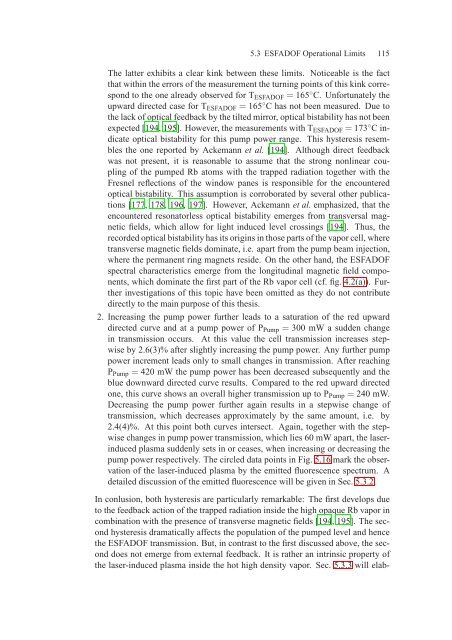Assessment of a Rubidium ESFADOF Edge-Filter as ... - tuprints
Assessment of a Rubidium ESFADOF Edge-Filter as ... - tuprints
Assessment of a Rubidium ESFADOF Edge-Filter as ... - tuprints
You also want an ePaper? Increase the reach of your titles
YUMPU automatically turns print PDFs into web optimized ePapers that Google loves.
5.3 <strong>ESFADOF</strong> Operational Limits 115<br />
The latter exhibits a clear kink between these limits. Noticeable is the fact<br />
that within the errors <strong>of</strong> the me<strong>as</strong>urement the turning points <strong>of</strong> this kink correspond<br />
to the one already observed for T <strong>ESFADOF</strong> = 165 ◦ C. Unfortunately the<br />
upward directed c<strong>as</strong>e for T <strong>ESFADOF</strong> = 165 ◦ C h<strong>as</strong> not been me<strong>as</strong>ured. Due to<br />
the lack <strong>of</strong> optical feedback by the tilted mirror, optical bistability h<strong>as</strong> not been<br />
expected [194, 195]. However, the me<strong>as</strong>urements with T <strong>ESFADOF</strong> = 173 ◦ C indicate<br />
optical bistability for this pump power range. This hysteresis resembles<br />
the one reported by Ackemann et al. [194]. Although direct feedback<br />
w<strong>as</strong> not present, it is re<strong>as</strong>onable to <strong>as</strong>sume that the strong nonlinear coupling<br />
<strong>of</strong> the pumped Rb atoms with the trapped radiation together with the<br />
Fresnel reflections <strong>of</strong> the window panes is responsible for the encountered<br />
optical bistability. This <strong>as</strong>sumption is corroborated by several other publications<br />
[177, 178, 196, 197]. However, Ackemann et al. emph<strong>as</strong>ized, that the<br />
encountered resonatorless optical bistability emerges from transversal magnetic<br />
fields, which allow for light induced level crossings [194]. Thus, the<br />
recorded optical bistability h<strong>as</strong> its origins in those parts <strong>of</strong> the vapor cell, where<br />
transverse magnetic fields dominate, i.e. apart from the pump beam injection,<br />
where the permanent ring magnets reside. On the other hand, the <strong>ESFADOF</strong><br />
spectral characteristics emerge from the longitudinal magnetic field components,<br />
which dominate the first part <strong>of</strong> the Rb vapor cell (cf. fig. 4.2(a)). Further<br />
investigations <strong>of</strong> this topic have been omitted <strong>as</strong> they do not contribute<br />
directly to the main purpose <strong>of</strong> this thesis.<br />
2. Incre<strong>as</strong>ing the pump power further leads to a saturation <strong>of</strong> the red upward<br />
directed curve and at a pump power <strong>of</strong> P Pump = 300 mW a sudden change<br />
in transmission occurs. At this value the cell transmission incre<strong>as</strong>es stepwise<br />
by 2.6(3)% after slightly incre<strong>as</strong>ing the pump power. Any further pump<br />
power increment leads only to small changes in transmission. After reaching<br />
P Pump = 420 mW the pump power h<strong>as</strong> been decre<strong>as</strong>ed subsequently and the<br />
blue downward directed curve results. Compared to the red upward directed<br />
one, this curve shows an overall higher transmission up to P Pump = 240 mW.<br />
Decre<strong>as</strong>ing the pump power further again results in a stepwise change <strong>of</strong><br />
transmission, which decre<strong>as</strong>es approximately by the same amount, i.e. by<br />
2.4(4)%. At this point both curves intersect. Again, together with the stepwise<br />
changes in pump power transmission, which lies 60 mW apart, the l<strong>as</strong>erinduced<br />
pl<strong>as</strong>ma suddenly sets in or ce<strong>as</strong>es, when incre<strong>as</strong>ing or decre<strong>as</strong>ing the<br />
pump power respectively. The circled data points in Fig. 5.16 mark the observation<br />
<strong>of</strong> the l<strong>as</strong>er-induced pl<strong>as</strong>ma by the emitted fluorescence spectrum. A<br />
detailed discussion <strong>of</strong> the emitted fluorescence will be given in Sec. 5.3.2.<br />
In conlusion, both hysteresis are particularly remarkable: The first develops due<br />
to the feedback action <strong>of</strong> the trapped radiation inside the high opaque Rb vapor in<br />
combination with the presence <strong>of</strong> transverse magnetic fields [194, 195]. The second<br />
hysteresis dramatically affects the population <strong>of</strong> the pumped level and hence<br />
the <strong>ESFADOF</strong> transmission. But, in contr<strong>as</strong>t to the first discussed above, the second<br />
does not emerge from external feedback. It is rather an intrinsic property <strong>of</strong><br />
the l<strong>as</strong>er-induced pl<strong>as</strong>ma inside the hot high density vapor. Sec. 5.3.3 will elab-
















